|
|
|
|
|
Oil On
Canvas, Real Flavor of Old Masters
|
|

|
ARTWORKS
INDEX
A B C D E F G H I J K L M N O P Q R S T U V W X Y Z |
ARTISTS
INDEX
A B C D E F G H I J K L M N O P Q R S T U V W X Y Z |
|
|
| | |
|
|
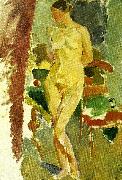 |
karl isakson -- Click Here
|
|
Karl Isakson, född 1878, död 1922, konstnär.
Karl Isakson växte upp i Stockholm, han och systern Ester uppfostrades av en religiös ensamstående mor, då fadern tidigt gått bort. |
|
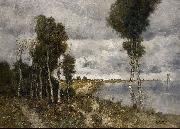 |
Karl Heffner -- Click Here
|
|
painted Am Ufer in 1849 - 1925 |
|
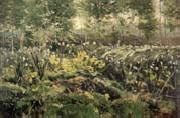 |
Karl Hagemeister -- Click Here
|
|
German, 1848-1933,German painter. He studied from 1871 at the Kunstschule in Weimar under Friedrich Preller, who introduced him to the principles of classical landscape painting. In 1873 he began to develop a more modern approach when he met Carl Schuch at the Hintersee, near Berchtesgaden; he immediately became his pupil and later wrote Schuch's biography. Schuch introduced Hagemeister to the Leibl circle (see LEIBL, WILHELM). He travelled to the Netherlands and Belgium (1873-4), Italy (1876) and France (1884-5), often accompanying Schuch and, in the early journeys, Wilhelm Trebner. His approach to landscape changed from classical Naturalism to 'pure painting', a more formalist approach in which purely pictorial qualities were given priority over naturalistic representation, as in Lake Shore (c. 1900; Schweinfurt, Samml. Schefer). His brushwork became broader, his depiction of objects became increasingly summary, and his colours lighter and cooler. Absorbing the influence of Japanese art through the interpretations of the French Impressionists, and following trends in international Art Nouveau, Hagemeister developed an individual variant of Jugendstil. His pictures were composed in accordance with decorative rather than naturalistic principles and became primarily ornamental, as in White Poppy |
|
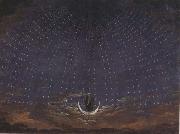 |
Karl friedrich schinkel -- Click Here
|
|
German Painter and Architect, 1781-1841
German architect and painter. As state architect of Prussia (from 1815), he executed many commissions for Frederick William III and other royal family members. He based his work on the revival of various historical styles. His mausoleum for Queen Louise (1810) and the brick and terra-cotta Werdersche Kirche, Berlin (1821 ?C 30), are among the earliest Gothic Revival designs in Europe. Other works include the Greek Revival Schauspielhaus (1818) and Altes Museum (1822 ?C 30), both in Berlin. In 1830 Schinkel became director of the Prussian Office of Public Works; his work as a city planner resulted in new boulevards and squares in Berlin. |
|
 |
Karl Friedrich Christian Welsch -- Click Here
|
|
German, 1828 - 1904 |
|
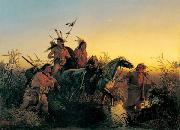 |
Karl Ferdinand Wimar -- Click Here
|
|
(also known as Charles Wimar and Carl Wimar) (1828-1862), was a German-American painter who concentrated on Native Americans in the West and the great herds of buffalo.
He is known for an early painting of a colonial incident: his The Abduction of Boone's Daughter by the Indians (1855-1856), a depiction of the 1776 capture near Boonesborough, Kentucky of Jemima Boone and two other girls by a Cherokee-Shawnee raiding party.
|
|
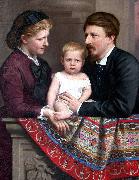 |
Karl Ernst Papf -- Click Here
|
|
Karl Ernest Papf (Dresden, Germany, 1833 -Sao Paulo, 1910) was a German painter, and draftsman that moved to Brazil in 1867.
He studied in the Academy of Fine Arts of Dresden and in 1867, was hired for the profession of photographer by the firm of his compatriot Albert Henschel. He initially worked in Recife until 1872, then in Salvador until 1877 - always in service of the atelier Albert Henschel & Cia., as written in Almanak Laemmert. He moved to Rio de Janeiro in surch for a better environment for the development of his work. |
|
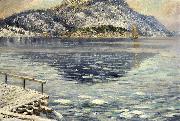 |
Karl Edvard Diriks -- Click Here
|
|
Norway (1855 -1930 ) - Painter
|
|
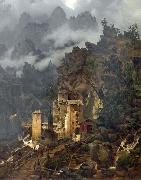 |
Karl Edaurd Biermann -- Click Here
|
|
painted Finstermunz Pass in Tyrol in 1830 |
|
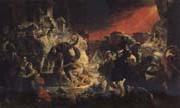 |
Karl Briullov -- Click Here
|
|
Russian Neoclassical/Romantic Painter, 1799-1852,was an internationally renowned Russian painter. He is regarded as a key figure in transition from the Russian neoclassicism to romanticism. Born of French parents in Saint Petersburg, Carlo Brulleau (as his name was spelled until 1822) felt drawn to Italy from his early years. Despite his education at the Imperial Academy of Arts (1809?C1821), Briullov never fully embraced the classical style taught by his mentors and promoted by his brother, Alexander Briullov. After distinguishing himself as a promising and imaginative student and finishing his education, he left Russia for Rome where he worked until 1835 as a portraitist and genre painter, though his fame as an artist came when he began doing historical painting. His best-known work, The Last Day of Pompeii (1830?C1833), is a vast composition compared by Pushkin and Gogol to the best works of Rubens and Van Dyck. It created a sensation in Italy and established Briullov as one of the finest European painters of his day. After completing this work, he triumphantly returned to the Russian capital, where he made many friends among the aristocracy and intellectual elite and obtained a high post in the Imperial Academy of Arts. |
|
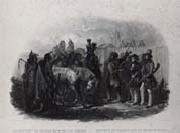 |
Karl Bodmer -- Click Here
|
|
Swiss Painter, 1809-1893,Swiss painter and graphic artist, active in the USA and France. His earliest exposure to art probably came from his uncle, the landscape painter and engraver Johann Jakob Meyer (1787-1858). When he was 22, Bodmer moved to Paris, where he studied art under Sebastien Cornu. In Paris he met his future patron, Prince Maximilian of Wied-Neuwied, who was planning an ambitious scientific expedition to North America. Bodmer was engaged to accompany the expedition and to provide sketches of the American wilderness. After touring the East Coast, the party made their way westward via the Ohio and Mississippi rivers to St Louis, MO, and in 1833 travelled up the Missouri River into country scarcely inhabited by white men. On the journey north to Ft MacKenzie, WY, Bodmer recorded the landscape and the groups of Indians they encountered. Having wintered in Ft Clark, ND, they returned to New York and then Europe in 1834. |
|
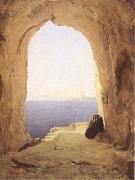 |
Karl Blechen -- Click Here
|
|
German Romantic, 1798-1840
sometimes given as Karl Blechen, was a German painter, specializing in fantastic landscapes, sometimes with demons and grotesque figures. Born in Cottbus, he drew the attention of prominent architect Karl Friedrich Schinkel, who cast him as a decorative painter. Blechen however aimed for higher work and began producing landscape paintings. In 1827 he went to Italy |
|
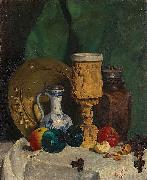 |
Karin Bergoo -- Click Here
|
|
painted Stilleben med frukter och krus in 1877 |
|
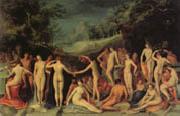 |
Karel van Mander -- Click Here
|
|
Dutch Mannerist Writer and Painter, 1548-1606
was a Flemish-born Dutch painter and poet, who is mainly remembered as a biographer of Netherlandish artists. As an artist he played an important role in Northern Mannerism in the Netherlands. He was born of a noble family at Meulebeke in modern West Flanders. He studied under Lucas de Heere at Ghent, and in 1568-1569 under Pieter Vlerick at Kortrijk. The next five years he devoted to the writing of religious plays for which he also painted the scenery. Then followed three years in Rome (1574-1577), where he is said to have been the first to discover the catacombs. On his return journey he passed through Vienna, where, together with the sculptor Hans Mont, he made the triumphal arch for the royal entry of the emperor Rudolph. In 1583 he settled in Haarlem where he lived and worked for 20 years on a commission by the city fathers to inventory "their" art collection; work that he later published in his "Schilder-boeck" (see below). While in Haarlem he continued to paint, concentrating his energy on his favorite genre: historical allegories. In 1603 he retired to the castle of Sevenbergen in Heemskerk to proofread his book that was published in 1604. |
|
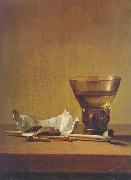 |
Karel Slabbaert -- Click Here
|
|
painted A toebackje still lifein 1641 |
|
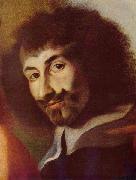 |
Karel skreta -- Click Here
|
|
(1610, Prague - July 30, 1674, Prague) was a Czech Baroque painter.
Karel learnt painting perhaps from one of the masters at the royal courtyard. He studied in Saxony and in Italy. According to Houbraken he painted portraits and lived together with the respected watercolor painter Willem Bouwer in Rome. He became a member of the Bentvueghels with the nickname Slagzwaart or Slach-sweerd.According to the RKD he was the teacher of the Prague painter Johann Georg Heinsch (1640-1713).
Since 1638 he lived in Prague, where he worked on altarpieces for many churches, for example St. Thomas, St. Stephen or the Church of Our Lady in front of Týn.
|
|
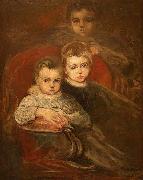 |
Karel Purkyne -- Click Here
|
|
(1834-1868) was a Czech painter. He was one of the most prominent proponents of realism in Czech art in the second half of the 19th century. He was the son of the physiologist and anatomist Jan Evangelista Purkyne, and developed an interest in art while still young. Early influences included the Baroque painters Karel Škreta and Petr Brandl and the paintings of the Dutch Golden Age. He spent a year in Munich studying with Johann Baptist Berdelle before traveling to Paris, where he worked with Thomas Couture; there he copied paintings by Old Masters and encountered the work of contemporary French artists. He was particularly struck by the works of Gustave Courbet. Upon returning to Prague, Purkyne became known primarily as a portraitist, though a handful of works in other genres are known. He also made a name for himself as an organizer of artistic events and as an art critic.
|
|
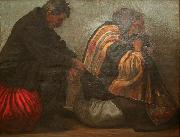 |
Karel Myslbek -- Click Here
|
|
Karel Myslbek (1874-1915)Aliases: Frant. VovesProfessions: Figure painter; Painter. |
|
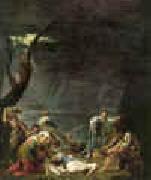 |
Karel Dujardin -- Click Here
|
|
1621-1678
Dutch
Karel Dujardin Locations
Dujardin was born in Amsterdam in 1640. After training with Nicolaes Berchem, he went to Italy when young, and became a member of the Society of Painters at Rome, among whom, he was known as Barba di Becco. In Rome, his works met with general approbation.
According to some sources, on his way back to his native country, he contracted considerable debts at Lyon, to free himself from which, he married his old and rich landlady. He went with her to Amsterdam, where his pictures were valued very highly. He soon secretly left his home in that city, probably from dislike of his wife, and went back to Rome in 1675, where he was welcomed by his old friends and admirers, and lived at great expense. After a vist to Tangier he went to Venice, where he died in 1678.
Most of his paintings are cabinet paintings of Italianate landscapes and or with farm animals and peasants. His landscapes have spirit and harmony, his figures expression, and his colour the brilliancy which distinguishes his school. His paintings are rare and command a high price. He also published fifty-two etchings of simiar subjects, with great spirit and ease.
He painted a single, fine, portrait (probably a self-portrait), and a pair of Baroque religious paintings on the life of St Paul, probably commissioned, as they lie well outside his normal style. One of these, and the portrait, are in the National Gallery, London |
|
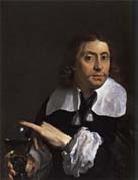 |
Karel du jardin -- Click Here
|
|
1626-78
Dutch painter, etcher and draughtsman. His father was Chaarles de Jardin (Gardyn; c. 1599-before 1650), a fat-renderer, and his mother was Catalyn Borchout (1588-before 1650). They had at least one other child, Herbert, who must have died by 1651 |
|
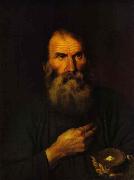 |
Kapiton Zelentsov -- Click Here
|
|
Kapiton Zelentsov (Russian 1790-1845) was a Russian painter notable for his illustrations for books by Aleksandr Pushkin, Faddei Bulgarin and Mikhail Zagoskin. He was the student of Alexey Venetsianov.
|
|
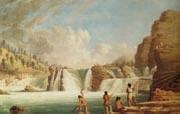 |
Kane Paul -- Click Here
|
|
Irish-born Canadian Painter
b.1810 d.1871
was an Irish-Canadian painter, famous for his paintings of First Nations peoples in the Canadian West and other Native Americans in the Oregon Country. A largely self-educated artist, Kane grew up in Toronto (then known as York) and trained himself by copying European masters on a study trip through Europe. He undertook two voyages through the wild Canadian northwest in 1845 and from 1846 to 1848. The first trip took him from Toronto to Sault Ste. Marie and back. Having secured the support of the Hudson's Bay Company, he set out on a second, much longer voyage from Toronto across the Rocky Mountains to Fort Vancouver and Fort Victoria in the Columbia District, as the Canadians called the Oregon Country. On both trips Kane sketched and painted Aboriginal peoples and documented their lives. Upon his return to Toronto, he produced more than one hundred oil paintings from these sketches. Kane's work, particularly his field sketches, are still a valuable resource for ethnologists. |
|
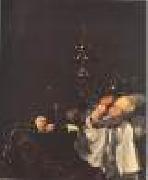 |
KALF, Willem -- Click Here
|
|
Dutch Baroque Era Painter, ca.1622-1693 |
|
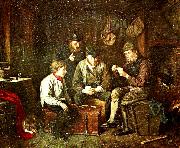 |
k. e. jansson -- Click Here
|
|
Karl Emanuel Jansson, född 7 juli 1846 i Finström, Åland, död 1 juni 1874 i Jomala, var en åländsk konstnär. Han var näst äldst av sju syskon. Han far, Jan Jansson, var en bonde i Pålsböle.
Sina konstnärliga inspiration fick han av sockenmålaren G Kjellgren, vid sex-sju års ålder, när han där lärde sig att läsa och skriva. Efter avlutad skolgång sattes han i skomakarlära. Efter ett år drogs han till Kjellgren och fungerade som hans hjälpreda. Kyrkoherden Frans von Knorring såg i slutet av 1859 några av hans teckningar. Han sände några till Finska Konstföreningens direktion och lovordade Karl.
Förening gav ett bidrag för att kunna studera vid Finska Konstföreningens ritskola i Åbo, under ledning av Robert Wilhelm Ekman. Av Ekman fick han husrum, rit- och målningsmaterial och en hel del extra undervisning. Karl gjorde stora framsteg under de 2 åren han målade med Ekman.
Jansson flyttade hösten 1862 till Stockholm, för att kunna utvecklas mer som artist, och inskrevs som elev vid Kongl. Akademin för de fria konsterna. Han tog anatomiexamen 1863. Han levde under svåra ekonomiska förhållanden och hade svårt att sälja sina verk.
Jansson fick hård kritik för de målningar han sände hem, exempelvis, Babian ätande en råtta, och konstföreningen betraktade dem med avsky. Han började då kritisera sig själv allt mer och mer, och den inställningen behöll han. Han fick inte den uppmärksammad han behövde. Tavlan Den förlorade sonens återkomst, belönades med ett pris. Han avslutade sin utbildning vid akademien 1867 med mycket beröm. Jansson lyckades utverka statsstöd för studier i Dusseldorf och reste dit på hösten 1868. Han åkte hem igen sommaren 1870 och tillbringade ett år på Åland innan han återvände till Dusseldorf.
Han var nu märkt av en tilltagande lungsjukdom. De sista verk han fullbordade var Talmannen och En slant i håven. För att lindra sin sjukdom reste han till Rom i mars 1872. Efter några månader åkte han runt till olika kurorter (Davos, Meran) men inget förbättrade hans tillstånd. Efter en liten tid i D??sseldorf kom han hem till Åland sensommaren 1873.
Karl flyttade in på Jomala gård, där lagman Lönnblad och hans fru tog hand om honom. Han målade några verk, vilka blev ofullbordade. På dödsbädden fick han veta att han belönats på världsutställningen i Wien för sina konstverk Klöveress och Talmannen, samt att han blivit medlem i konstakademin i Sankt Petersburg. Han dog 1 juni 1874, inte ens fylld 28 år. |
|
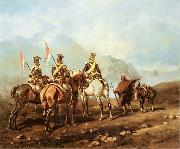 |
Juliusz Kossak -- Click Here
|
|
(Nowy Wiśnicz, 15 December 1824 - 3 February 1899, Krakew) was a Polish historical painter and master illustrator who specialized in battle scenes, military portraits and horses. He was the progenitor of an artistic family that spanned four generations. father of painter Wojciech Kossak and grandfather of painter Jerzy Kossak.
Juliusz Kossak grew up in Lwew during the military partitions of Poland. He obtained a degree in law at the Lwew University encouraged by his mother. At the same time he studied painting with Jan Maszkowski and Piotr Michałowski. Beginning in 1844 Kossak worked on commissions for the local aristocracy in Malopolska, Podolia and Wolyn. He married Zofia Gałczyka in 1855 and together they left for Paris where they spent five years. His sons were born there, the twin brothers: Wojciech and Tadeusz (on New Year's Eve 1856-1857) and the younger Stefan in 1858. The family came to Warsaw in 1860 where Kossak obtained a position as the head illustrator and engraver for Tygodnik Illustrowany magazine. They moved to Munich for a year and in 1868 settled in Krakew blessed with five children already. Kossak bought a small estate there, known as Kossakewka, famed for artistic and literary salon frequented by Adam Asnyk, Henryk Sienkiewicz, Stanisław Witkiewicz, Jezef Chełmoki and many others. Juliusz Kossak lived and worked there till the end of his life. In 1880 he was awarded the Cross of Order of Merit by Emperor Franz Joseph of Austria-Hungary for his lifetime achievements as an artist.
|
|
 |
Julius Kronberg -- Click Here
|
|
1850-1921,Swedish painter and illustrator. He was educated at the Konstakademi in Stockholm, where his teachers were J. C. Boklund (1817-80), August Malmstr?m and Johan Fredrik H?ckert. In 1873 he travelled on a scholarship to D?sseldorf, and in the following year he went to Munich. There he was strongly influenced by the Old Masters (especially Rubens), as well as Hans Makart robustly theatrical style. Together they shaped Kronberg early works, for example Hunting Nymph and Fauns (1875; Stockholm, Nmus.), which caused a sensation when it was exhibited in Stockholm in 1876 and established his reputation. Kronberg left Munich in 1877 and settled in Rome, where, between trips to Egypt and Tunisia, he stayed until 1889, when he returned to Stockholm. During his years in Rome his style became increasingly austere. His exuberant Munich manner was replaced by a colder illusionism, which emphasized the historical details of subjects taken from the Bible and Shakespeare. Typical is David and Saul (1885; Stockholm, Nmus.), which reflected his study of Lawrence Alma-Tadema. |
|
|
|
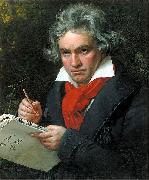 |
Joseph Karl Stieler -- Click Here
|
|
(1 November 1781 - 9 April 1858) was a German painter. Born in Mainz to a family of engravers and die-cutters, Stieler received some artistic training from his father, August Friedrich Stieler (1736 - 1789). Stieler began his career as a painter of miniatures.
His portrait style was most especially shaped during his work in the Parisian atelier of Francois Gerard, a student of Jacques-Louis David. In 1808, he established himself as an independent portraitist in Frankfurt am Main. He traveled through Italy in 1810. In 1816, he traveled to Vienna to paint the portrait of Emperor Francis I of Austria. Between February and April 1820, he worked on his portrait of Beethoven, which is probably the most well-known representation of the composer today.
Stieler worked mainly in the service of the Bavarian court. His painted likenesses in Schloss Nymphenburg, Schönheitengalerie, the so-called Gallery of Beauties, were commissioned by King Ludwig I. Stieler also painted the portraits of Goethe, Amalia of Greece, Friedrich Wilhelm Joseph von Schelling, Johann Ludwig Tieck, and Alexander von Humboldt.
The most distinguishing feature of Stieler's portraits is his utter focus on the sitter. Decorative additions are left out, and there is nothing that distracts the viewer's scrutiny. Stieler accomplished this concentration through deliberate light - dark contrast, which above all highlights the accurately characterized facial features.
He died in Loytown.
|
|
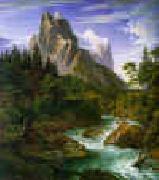 |
Joseph Anton Koch -- Click Here
|
|
1768-1839
Austrian
Joseph Anton Koch Galleries
was an Austrian painter of the German Romantic movement. The Tyrolese painter left academic training in the Karlsschule Stuttgart, a strict military academy, and traveled through France and Switzerland. He arrived in Rome in 1795. Koch was close to the painter Asmus Jacob Carstens and carried on Carstens' 'heroic' art, at first in a literal manner.
After 1800 Koch developed as a landscape painter. In Rome he espoused a new type of 'heroic' landscape, revising the classical compositions of Poussin and Lorrain with a more rugged, mountainous scenery. He left Rome in 1812 and stayed in Vienna until 1815, in protest of the French invasion. During this period he incorporated more non-classical themes in his work. In Vienna he was influenced by Friedrich Schlegel and enthusiasts of old German art. In response, his style became harsher, and this new approach had a wide influence on German landscape painters who visited Rome. |
|
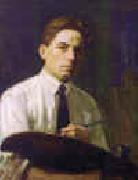 |
Joseph A Kleitsch -- Click Here
|
|
1885-1931
Joseph Kleitsch (1885-1931) was an American painter who holds a high place in the early California School of Impressionism. Born in Banad, Hungary on June 6th, 1885, young Joseph Kleitsch was drawn to paint at the early age of seven, he later pursued his professional art training at Budapest, Munich and Paris. Influenced by his visits to the famous museums of Europe, Kleitsch continued with his love of portrait and figuritive painting after relocating to California. There he rose to the challenge of capturing his new environment's brilliant light and diverse landscape. Living in Los Angeles for a while, Kleitsch fell in love with the rustic artist village of Laguna Beach. There he painted the town's eucalyptus lined streets, the crashing waves of the Pacific coastline and the nearby Mission San Juan Capistrano. Arthur Millier of the Los Angeles Times in 1922 was quoted saying of Kleitsch "he was a born colorist; he seemed to play on canvas with the abandon of a gypsy violinist". Joseph Kleitsch died at the age of forty-nine in Santa Ana, California on November 16th, 1931. |
|
|
|
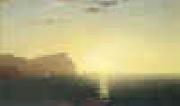 |
John Kensett -- Click Here
|
|
1816-1872
John Kensett Art Galleries
Artist John Frederick Kensett was born on March 22, 1816 in Cheshire, Connecticut, and died on December 14, 1872 in New York City. He attended school at Cheshire Academy, and studied engraving with his immigrant father, Thomas Kensett, and later with his uncle, Alfred Dagget. He worked as engraver in the New Haven area until about 1838, after which he went to work as a bank note engraver in New York City.
In 1840, along with Asher Durand and John William Casilear, Kensett traveled to Europe in order to study painting. There he met and traveled with Benjamin Champney. The two sketched and painted throughout Europe, refining their talents. During this period, Kensett developed an appreciation and affinity for 17th century Dutch landscape painting. Kensett and Champney returned to the United States in 1847.
After establishing his studio and settling in New York, Kensett traveled extensively throughout the Northeast and the Colorado Rockies as well as making several trips back to Europe.
Kensett is best known for his landscape of upstate New York and New England and seascapes of coastal New Jersey, Long Island and New England. He is most closely associated with the so-called "second generation" of the Hudson River School. Along with Sanford Robinson Gifford, Fitz Hugh Lane, Jasper Francis Cropsey, Martin Johnson Heade and others, the works of the "Luminists," as they came to be known, were characterized by unselfconscious, nearly invisible brushstrokes used to convey the qualities and effects of atmospheric light. It could be considered the spiritual, if not stylistic, cousin to Impressionism. Such spiritualism stemmed from Transcendentalist philosophies of sublime nature and contemplation bringing one closer to a spiritual truth.
In 1851 Kensett painted a monumental canvas of Mount Washington that has become an icon of White Mountain art. Mount Washington from the Valley of Conway was purchased by the American Art Union, made into an engraving by James Smillie, and distributed to 13,000 Art Union subscribers throughout the country. Other artists painted copies of this scene from the print. Currier and Ives published a similar print in about 1860. This single painting by Kensett helped to popularize the White Mountain region of New Hampshire.
Kensett's style evolved gradually, from the traditional Hudson River School manner in the 1850s into the more refined Luminist style in his later years. By the early 1870s Kensett was spending considerable time at his home on Contentment Island, on Long Island Sound near Darien, Connecticut. |
|
|
|
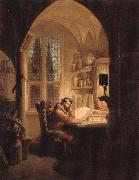 |
john keats -- Click Here
|
|
Born: 31 October 1795
Birthplace: Near London, England
Died: 23 February 1821 (tuberculosis)
Best Known As: Romantic poet who wrote "Ode to a Nightingale"
|
|
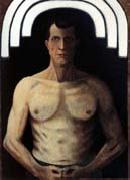 |
John Kane -- Click Here
|
|
1860-1934
American painter of Scottish birth. In 1879 Kane emigrated to western Pennsylvania. He worked as a bricklayer, coal miner, steel worker and carpenter in the Ohio River valley and, in 1890, began to sketch local scenery. After losing his leg in a train accident in 1891, he was employed painting railway carriages. When his son died in 1904, Kane left his family and spent years wandering and working in odd jobs; his earliest surviving paintings date from around 1910. Settling in Pittsburgh, he worked as a house painter and in his spare time painted portraits, religious subjects, the city's urban landscape and memories of his Scottish childhood. In 1927 the jury of the Carnegie International Exhibition, Pittsburgh, encouraged by the painter-juror Andrew Dasburg (b 1887), accepted Kane's Scene in the Scottish Highlands (1927; Pittsburgh, PA, Carnegie Mus. A.). Kane's success, at first considered a hoax by the press, was based on the modernist interest in primitive and folk art. His work was regarded as non-academic and boldly original, and he became the first contemporary American folk artist to be recognized by a museum. Larimer Avenue Bridge (1932; Pittsburgh, PA, Carnegie Mus. A.) is characteristic of his style with its meticulous detail, flat colour and dominant green and red. Though he sketched and painted on the site, Kane freely transposed pictorial elements to create a more pleasing composition. This innate compositional sense is evident in his Self-portrait (1929; New York, MOMA). |
|
 |
John Frederick Kensett -- Click Here
|
|
American Hudson River School Painter, 1816-1872
He attended school at Cheshire Academy, and studied engraving with his immigrant father, Thomas Kensett, and later with his uncle, Alfred Dagget. He worked as engraver in the New Haven area until about 1838, after which he went to work as a bank note engraver in New York City. In 1840, along with Asher Durand and John William Casilear, Kensett traveled to Europe in order to study painting. There he met and traveled with Benjamin Champney. The two sketched and painted throughout Europe, refining their talents. During this period, Kensett developed an appreciation and affinity for 17th century Dutch landscape painting. Kensett and Champney returned to the United States in 1847. After establishing his studio and settling in New York, Kensett traveled extensively throughout the Northeast and the Colorado Rockies as well as making several trips back to Europe. Kensett is best known for his landscape of upstate New York and New England and seascapes of coastal New Jersey, Long Island and New England. He is most closely associated with the so-called "second generation" of the Hudson River School. Along with Sanford Robinson Gifford, Fitz Hugh Lane, Jasper Francis Cropsey, Martin Johnson Heade and others, the works of the "Luminists," as they came to be known, were characterized by unselfconscious, nearly invisible brushstrokes used to convey the qualities and effects of atmospheric light. It could be considered the spiritual, if not stylistic, cousin to Impressionism. Such spiritualism stemmed from Transcendentalist philosophies of sublime nature and contemplation bringing one closer to a spiritual truth. |
|
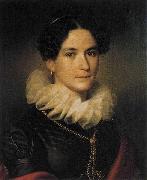 |
Johann Peter Krafft -- Click Here
|
|
(15 September 1780 - 28 October 1856) was a German-Austrian painter.
Krafft was born in Hanau, Hesse. At the age of ten, he began his art studies at the Hanau Akademie. In 1799, he moved to Vienna and studied at the Academy of Fine Arts for three years under the tutelage of Heinrich Feger. From 1802 to 1808, he studied in Paris, with Jacques-Louis David and François Gerard, and then in Rome. On his return to Vienna, he became a successful professional painter, producing numerous portraits.
In 1828, Krafft became director of the Imperial and Royal Picture Gallery in Belvedere Palace.
Johann Peter Krafft died at the age of 76 in Vienna, where he was buried at the Zentralfriedhof. |
|
|
|
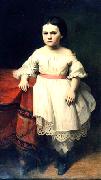 |
Johann Koler -- Click Here
|
|
(8 March 1826, in Vastemõisa near Suure-Jaani, Viljandi County, Estonia - 22 April 1899 in St. Petersburg, Russia) was an Estonian painter. He is considered to have been the first professional Estonian painter. He distinguished himself primarily by his portraiture and to a lesser extent by his landscape paintings. Some of his most notable pictures depict the Estonian rural life in the second half of the 19th Century.
Johann Köler was the seventh child born to a peasant family. Despite the poverty of the parents Köler managed to attend the elementary and the district schools in Viljandi. Then he attended a workshop of master painters in Cesis (then in Livonia).
In 1846, Köler travelled to St. Petersburg to work as a sign writer, where his talent was soon discovered. From 1848 to 1855 Johan Köler studied drawing and painting at the St. Petersburg Imperial Academy of Arts.
During 1857 Köler travelled to Paris via Berlin, later returned to Germany then travelled to the Netherlands and Belgium. In 1858, he travelled across the Alps to Milan, Geneva, Florence and Rome. There, he studied in a private academy and devoted his time to watercolor technique. In Rome during 1859 he presented his composition "Christ on the Cross".
Answering the call of the St. Petersburg Academy of Arts, Köler returned to the city in 1861. From 1862 to 1874 he was a teacher of the Grand Duchess Maria Aleksandrovna, the daughter of Czar Alexander II of Russia. In 1869-1870, he worked as a lecturer at the St. Petersburg Academy of Arts. From 1886 to 1889 Johan Köler worked in Vienna, Nice and Paris. |
|
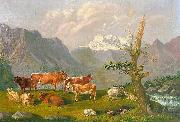 |
Johann Kaspar Scherrer -- Click Here
|
|
painted Weidelandschaft in den Schweizer Bergen mit Katarakt und Gebirgshorizont in 1739 - 1806 |
|
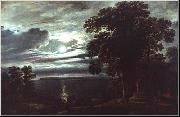 |
Johann Christian Klengel -- Click Here
|
|
Johann Christian Klengel (1751-1824), painter. |
|
 |
Johann Bernhard Klombeck -- Click Here
|
|
painted A Forest Scene in 1857 |
|
 |
johan krouthen -- Click Here
|
|
född 2 november 1858, död i december 1932, var en svensk idealistisk konstnär.
Krouthen föddes i Linköping och var son till handlaren Conrad Krouthen och Hilda Åberg. Släkten Krouthen kom från Norrköping och flera generationer hade arbetat som tenngjutare. Familjenamnet Krut ändrades genom att varubeteckningen Krut-tenn förfranskades till Krouthen. Conrad Krouthen kom till Linköping 1850 och startade en manufakturaffär vid Stora torget. Affären gick bra och 1857 kunde han gifta sig med sömmerskan Hilda Åberg.
Krouthen kunde växa upp i ett välmående hem och han fick börja skolan på läroverket i Linköping. Vid 14 års ålder slutade han skolan och började arbeta åt fotografen och målaren Svante Leonard Rydholm som hade en atelje vid St. Larsplan. Krouthen fick lära sig grunderna i både målning och fotografering och vid 16 års ålder började han på Konstakademiens principskola i Stockholm 1875. Den treåriga utbildningen innebar att eleverna fick lära sig att rita av klot och profiler, djur och växter. Efter de tre åren fick Krouthen fortsätta vid akademin. I kursen "Lägre antiken" fick eleverna rita av gipsmodeller, i "Högre antiken" teckna efter levande model och i "Landskapsskolan" fick eleverna måla landskap. Under studietiden sökte sig många elever utanför skolan och Krouthen lärde känna konstnären Edvard Perseus. Perseus var kritisk till utbildningen på akademin och tog med sina elever bland annat till Mariefred och Gripsholms slott för att måla av naturen. |
|
 |
Johan Fredrik Krouthen -- Click Here
|
|
Swedish, 1858-1932 |
|
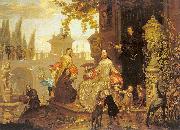 |
Jan Van Kessel the Younger -- Click Here
|
|
1654-1708
Dutch
Jan Van Kessel Gallery |
|
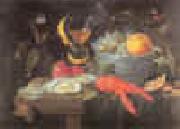 |
Jan Van Kessel -- Click Here
|
|
1626-1679
Dutch
Jan Van Kessel Gallery
Dutch painter and draughtsman. He was a follower, and probably a pupil, of Jacob van Ruisdael and covered the same range of subjects painted by Ruisdael, with the exception of marine paintings. However, van Kessel is best known for his townscapes and panoramic views, as exemplified by the Sluice and the New City Ramparts of Amsterdam in Winter (Amsterdam, Hist. Mus.) and the Bleaching Grounds near Haarlem (Brussels, Mus. A. Anc.). He imitated the water-mills and village scenes of his friend Meindert Hobbema, as well as the waterfalls of Allaert van Everdingen, the wooded landscapes of Jan Wijnants and the winter scenes of Jan van de Cappelle. Many of van Kessel's 120 surviving pictures, including The Avenue (Stuttgart, Staatsgal.) and the Ford in the Woods (Dresden, Gem?ldegal. Alte Meister), were once attributed to van Ruisdael and these other masters (often with an authentic signature covered by the better-known name). Van Kessel is also frequently confused with other minor artists in van Ruisdael's circle, especially Jan Vermeer van Haarlem the younger, Isaac Koene (1637/40-1713), Jacob Salomonsz. van Ruysdael (1629/30-1681) and Anthonie van Borssom. As a draughtsman, van Kessel emulated van Ruisdael's mature style, working almost exclusively in black chalk and grey wash. The best of his 70 drawings are townscapes, although his studies of trees and depictions of farmsteads are noteworthy. A number of correlations exist between his sketches and paintings. There is no known relationship with the Flemish artists of the same name. |
|
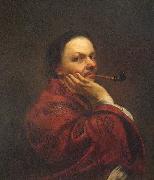 |
Jan Kupecky -- Click Here
|
|
(in German: Johann Kupetzky, in Hungarian: Kupecky Jenos, or Kupeczky Jenos, 1667, Bazin, Royal Hungary (today Slovakia) - 1740, Nernberg, Germany) was a Czech and Slovak portrait painter during the baroque. He was active in Hungary, Slovakia, Vienna and Nernberg.
Kupecký, like many people at that time, was the son of Protestant (Czech Brethren) parents from the Czech lands (Mlade Boleslav) who sought refuge in Slovakia (constituting the core of Royal Hungary at that time) from religious persecution by the Catholics. He was born in Pezinok - a town near Bratislava.
According to the sources he began his studies with the Swiss painter Benedikt Klaus, who was active in both Vienna and in Royal Hungary. At the age of twenty, Kupecký went on a long Italian study trip. In Rome Prince Aleksander Benedykt Sobieski, the son of the Polish king John III Sobieski, helped him to become famous. He returned to Vienna in 1709, after twenty-two years spent in Venice and Rome. We know very little of his Italian activity as well as his early works and his setting in Vienna.
According to his contemporary biographer, the Swiss Johann Caspar Fessli, the Protestant Kupecký, who faithfully clung to his ancestor's religion, remained withdrawn and isolated in Vienna's Catholic milieu, which was under the influence of the court and the aristocracy. However this concept is partly contradicted by the fact that the master had significant courtly commissions while working in Vienna. He painted portraits of various members of the dynasty, Prince Eugene of Savoy, several aristocrats, and, in Karlovy Vary, even of the Russian Czar Peter I. The rich ceuvre of this period comprises a series of gorgeous portraits of Kupecky's family, friends and the painter himself, as well as several persons, whose identity in unknown.
In 1733 Kupecký, fearing religious persecution, fled from Vienna to Nernberg with his family and worked there until his death in 1740. As the most significant portrait painter of contemporary Germany, he was commissioned by a large number of German princes, church dignitaries rich merchants and scholars, and his works were popularized by engravings even during his lifetime. Through his pupils and followers Kupecký's influence and artistic example remained alive and widespread for a long time.
|
|
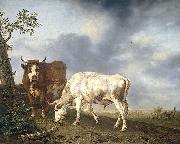 |
Jan Kobell -- Click Here
|
|
(born Delfshaven, 1779; died Amsterdam, 14 September 1814) was a Dutch animal and landscape painter.
He was a pupil of Willem Rutgaart van der Wall at Utrecht. He studied diligently from nature, and took Paul Potter for his model, acquiring his talent for animal as well as landscape work. In 1812 he went to Paris, where he won the gold medal and high praise from art critics. His popularity increased rapidly until his premature death. Of his cattle pieces, noted for their technique and precision of drawing, there are excellent specimens in the museums of Amsterdam and Rotterdam.
|
|
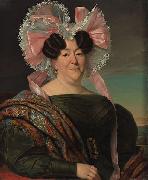 |
Jan Adam Kruseman -- Click Here
|
|
Petrus Augustus de Genestet (P.A. de Genestet) (Amsterdam, November 21, 1829 - Rozendaal, July 2, 1861) was a Dutch poet and a theologian.
Petrus Augustus de Genestet lost both of his parents at a very young age; after that he lived with his uncle, the Dutch painter Jan Adam Kruseman. He studied at the Amsterdamse Atheneum and the Seminarium der Remonstrantse Broederschap to become a preacher. He became minister in March of 1852 at the Genestetkerk (Genestetchurch) that was named after him, in Delft. In the same year he got married to Henriette Bienfait in Bloemendaal. They had two children. In 1859, he lost both his wife and oldest child died of tubercolosis, and because of his poor health he had to quit working as a minister. He moved to Amsterdam, but spent most of his summers in Bloemendaal. Two years later, in 1861, he died in Rozendaal. |
|
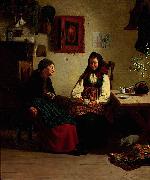 |
Jakob Kulle -- Click Here
|
|
painted Allmogeinterior med kaffedrickande kvinnor in 1876 |
|
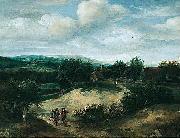 |
Jacob Koninck -- Click Here
|
|
(c. 1615, Amsterdam - c. 1695, Copenhagen), was a Dutch Golden Age landscape painter.
According to Houbraken he lent his books on perspective to Johannes Verkolje, who became better than he was at perspective drawing.He was a disciple of Adriaen van de Velde who became a popular painter in Copenhagen where he painted for the court of Christian V of Denmark.
According to the RKD he was the uncle of Salomon Koninck, a pupil of David Colijns and became the teacher of his son Jacob II and his younger brother Philips Koninck.He was in Dordrecht from 1633-1636, Rotterdam from 1637-1645, The Hague from 1647-1651, back in Amsterdam in 1658 (when he probably lent young Verkolje his perspective books), and moved to Denmark in 1676.
|
|
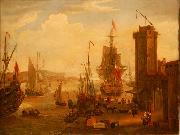 |
Jacob Knyff -- Click Here
|
|
(January 1, 1639, Haarlem - 1681, London), was a Dutch Golden Age painter.
According to Houbraken he was the teacher of Johannes Gottlieb Glauber in Paris in 1671, where he attended the funeral of Nicolaes Berchem II on January 4, 1672. he was probably the son of the painter Wouter Knijff, and is known for painting landscapes and seascapes |
|
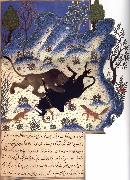 |
Jackals Kalila and Dimna -- Click Here
|
|
the period of 1465-1535
|
|
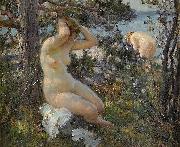 |
Ivar Kamke -- Click Here
|
|
Sweden (1882 -1936 ) - Painter
|
|
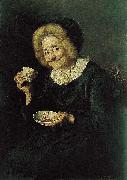 |
Ivana Kobilca -- Click Here
|
|
Ivana Kobilca (20 December 1861 - 4 December 1926) was a Slovene realist painter who lived, worked and studied in various European cities including Vienna, Sarajevo, Berlin, Paris and Munich. She was a member of Societe Nationale des Beaux Arts in Paris. Many of her paintings are still lifes, portraits or country settings. She later tended toward impressionism.
Her best known paintings are Kofetarica (Coffeemadam), 1888; Citrarica (The Zitherist), Likarice (Women Ironers), 1891; Holandsko dekle (A Dutch Girl), Portret sestre Fani (Portrait of Sister Fani), 1889; and Poletje (Summer), 1889. |
|
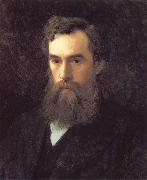 |
Ivan Nikolaevich Kramskoy -- Click Here
|
|
Russian Painter, 1837-1887 |
|
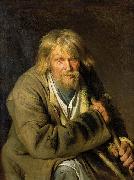 |
Ivan Nikolaevich Kramskoi -- Click Here
|
|
(June 8 (O.S. May 27), 1837 ?C April 6 (O.S. March 24), 1887; was a Russian painter and art critic. He was an intellectual leader of the Russian democratic art movement in 1860-1880.
Kramskoi came from a poor petty-bourgeois family. From 1857 to 1863 he studied at the St. Petersburg Academy of Arts; he reacted against academic art and was an initiator of the "revolt of fourteen" which ended with the expulsion from the Academy of a group of its graduates, who organized the Artel of Artists
Influenced by the ideas of the Russian revolutionary democrats, Kramskoi asserted the high public duty of the artist, principles of realism, and the moral substance and nationality of art. He became one of the main founders and ideologists of the Company of Itinerant Art Exhibitions (or Peredvizhniki). In 1863-1868 he taught at the drawing school of a society for the promotion of applied arts. He created a gallery of portraits of important Russian writers, scientists, artists and public figures (Lev Nikolaevich Tolstoy, 1873, Ivan Shishkin, 1873, Pavel Mikhailovich Tretyakov, 1876, Mikhail Saltykov-Shchedrin, 1879, Sergei Botkin, 1880) in which expressive simplicity of composition and clarity of depiction emphasize profound psychological elements of character. Kramskoi's democratic ideals found their brightest expression in his portraits of peasants, which portrayed a wealth of character-details in representatives of the common people.
In one of Kramskoi's most well known paintings, Christ in the Desert (1872, Tretyakov gallery), he continued Alexander Ivanov's humanistic tradition by treating a religious subject in moral Cphilosophical terms. He imbued his image of Christ with dramatic experiences in a deeply psychological and vital interpretation, evoking the idea of his heroic self-sacrifice.
Aspiring to expand the ideological expressiveness of his images, Kramskoi created art that existed on the cusp of portraiture and genre-painting ("Nekrasov during the period of 'Last songs,'" 1877-C78; "Unknown Woman," 1883; "Inconsolable grief," 1884; all in Tretyakov gallery). These paintings disclose their subjects' complex and sincere emotions, their personalities and fates. The democratic orientation of Kramskoi's art, his acute critical judgments about it, and his persistent quest for objective public criteria for the evaluation of art exerted an essential influence on the development of democratic art and aesthetics in Russia in the last third of the nineteenth century.
|
|
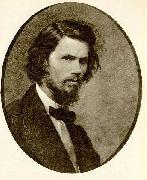 |
Ivan Kramskoi -- Click Here
|
|
(June 8 (O.S. May 27), 1837 C April 6 (O.S. March 24), 1887) |
|
 |
Ivan Khrutsky -- Click Here
|
|
1810-1885 Russian Ivan Khrutsky Gallery was a Russian-Polish painter known by his still-lives and portraits. He was born Ivan Fomich Khrutsky into a family descended from Polish gentry in the village of Ula, Vitebsk Gubernia (currently Belarus). In 1827, Khrutsky came to St. Petersburg and in 1830 entered the Imperial Academy of Arts. His first known works are dated 1832. The paintings gradually gathered public and critical acclaim. Khrutsky also worked as an interior designer, and became a popular amongst the wealthy home owners. In 1836, Khrutsky was awarded the Major Silver medal of the Academy for his still-lifes. Khrutsky also executed nice genre pictures and portraits. Old Woman Knitting a Sock, brought him the Minor Gold medal of the Academy. In 1839 he was awarded the title of the Academician. After his father??s death in 1840 Khrutsky left St. Petersburg forever and settled in the family estate Zakharenichi (Zacharniczy), Polotsk region. This period was one of commissioned religious art, mostly from Lithuania. Besides religious paintings he also worked on portraits, such as I.I. Glazunov's, Joseph Semashko's, Mikolaj Malinowski's and others. He died in 1885. |
|
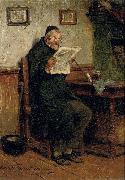 |
Hugo Wilhelm Kauffmann -- Click Here
|
|
(7 August 1844 - 30 December 1915) was a German painter, the son of Hermann Kauffmann.
Kauffmann was born in Hamburg. In 1861 he went to Frankfurt and worked there under Jakob Becker, Edward Jakob von Steinle and Johann Nepomuk Zwerger. From 1863-71 he lived in Kronberg in the Taunus. During this time he spent one winter in Hamburg and a five-month period in Desseldorf too; afterwards he spent 1½ years in Paris, until 1870 when the war drove him out. He lived until 1871 in Munich. He died in Prien at the Chiemsee in 1915.
|
|
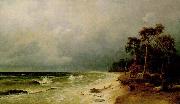 |
Hugo Knorr -- Click Here
|
|
painted Ostseestrand in 1880 |
|
 |
Henry John Yeend King -- Click Here
|
|
an important Victorian genre and landscape artist . English,1855-1924
|
|
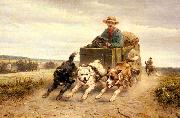 |
Henriette Ronner-Knip -- Click Here
|
|
was a Dutch painter.
Born Henriëtte Knip in Amsterdam, she moved at a young age to Den Bosch and was until 1850 active in Sint-Michielsgestel and Boxtel. That year she married Feico Ronner and moved to Belgium, first to Brussels and in 1878 to Elsene. She studied with her father, Joseph August Knip.
She was best known for her paintings of subjects from nature, especially cats and dogs.
|
|
|
|
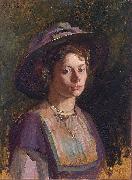 |
Heinrich Martin Krabbe -- Click Here
|
|
painted Young Lady in 19th/20th century
|
|
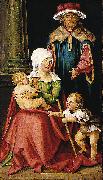 |
Hans von Kulmbach -- Click Here
|
|
(real name Hans Suess or Hans Seß) was born around 1480 in Kulmbach, Franconia and died previous to Dec. 3, 1522 in Nuremberg. Hans von Kulmbach was the artist who created the Krakew St. John's Altar.
Kulmbach probably arrived in Nuremberg around 1505. He received instruction by Jacopo de' Barbari, who for a time worked in Nuremberg. Von Kulmbach then apprenticed with Albrecht Derer and after Derer retired from painting altarpieces in 1510 Kulmbach took over most of his commissions. Kulmbach had his own workshop in Nuremberg and at times worked in Krakew. He also created artworks for emperor Maximilian I and for Margrave Casimir Hohenzollern von Brandenburg-Kulmbach. His best works were stained-glass windows in churches, such as the Maximilian stained-glass, Margrave stained-glass at St. Sebald in Nuremberg, the Welser stained-glass at the Frauenkirche and the Nikolaus altar at Lorenzkirche. In 1511 he finished the St. Mary's altar at Skałka in Krakew. The Catherine and St. John's altar also in Krakew, are among his best works.
|
|
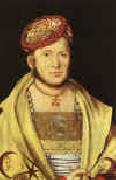 |
Hans Suss von Kulmbach -- Click Here
|
|
1476-1522
German
Hans Suss von Kulmbach Gallery
German painter and graphic artist. His real name was Hans S??ss. In general his work reveals the influence of D??rer, but he had little of the master's power. Von Kulmbach worked chiefly in Nuremberg, although he probably spent several years in Cracow as court painter. His masterpiece is the Tucher altarpiece for the Church of St. Sebald in Nuremberg. He also executed portraits and designs for painted glass.
|
|
 |
Hans Knieper -- Click Here
|
|
painted Portrait of Frederick II of Denmark and Norway in 1581
|
|
 |
Gustav Klimt -- Click Here
|
|
Austrian Art Nouveau Painter, 1862-1918
Gustav Klimt (July 14, 1862 ?C February 6, 1918) was an Austrian Symbolist painter and one of the most prominent members of the Vienna Art Nouveau (Vienna Secession) movement. His major works include paintings, murals, sketches, and other art objects, many of which are on display in the Vienna Secession gallery. Klimt's primary subject was the female body, and his works are marked by a frank eroticism--nowhere is this more apparent than in his numerous drawings in pencil.
Klimt's work is distinguished by the elegant gold or coloured decoration, often of a phallic shape that conceals the more erotic positions of the drawings upon which many of his paintings are based. This can be seen in Judith I (1901), and in The Kiss (1907?C1908), and especially in Danaë (1907). One of the most common themes Klimt utilized was that of the dominant woman, the femme fatale. Art historians note an eclectic range of influences contributing to Klimt's distinct style, including Egyptian, Minoan, Classical Greek, and Byzantine inspirations. Klimt was also inspired by the engravings of Albrecht D??rer, late medieval European painting, and Japanese Rimpa school. His mature works are characterized by a rejection of earlier naturalistic styles, and make use of symbols or symbolic elements to convey psychological ideas and emphasize the "freedom" of art from traditional culture. |
|
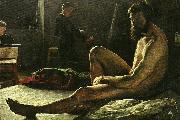 |
gottfrid kallstenius -- Click Here
|
|
seated male model, 1887-88.
royal academy of fine arts |
|
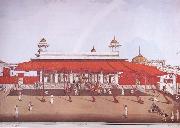 |
Ghulam Ali Khan of Delhi -- Click Here
|
|
fl.1815-1852
Delhi,Dated 18 |
|
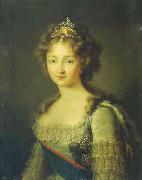 |
Gerhard von Kugelgen -- Click Here
|
|
Franz Gerhard von Kegelgen (February 26, 1772 - March 27, 1820) was a German painter, noted for his portraits and history paintings. He was a professor at the Academy of Arts in Dresden and a member of both the Prussian and Russian Academies of Arts. His twin brother, Karl von Kegelgen, was also a painter of note.
Gerhard von Kegelgen was born at Bacharach am Rhein. After leaving school in 1789, he studied painting in Koblenz. Beginning in 1791, he worked in Bonn, where he painted portraits of Elector Archduke Maximilian Franz of Austria, minister Ferdinand August von Spiegel zum Desenberg, and the Earl of Waldstein. Afterwards, Gerhard von Kegelgen and his brother undertook an educational journey to Rome, Munich and Riga, which was financed by Maximilian Franz of Habsburg.
In 1800, Kegelgen married Helene Marie Zoege von Manteuffel. They had three children together. His first son, Wilhelm was born in Saint Petersburg in 1802, and also grew up to become a painter. The other children were Gerhard (born 1806), and Adelheid (born 1808).
|
|
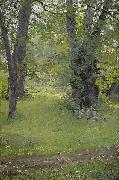 |
Gerda Roosval-Kallstenius -- Click Here
|
|
painted Park with sitting man and dog in 1890 |
|
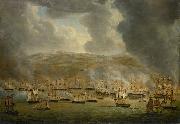 |
Gerardus Laurentius Keultjes -- Click Here
|
|
painted The assault on Algiers by the allied Anglo-Dutch squadron in 1817
|
|
|
|
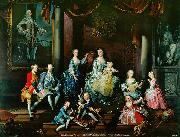 |
George Knapton -- Click Here
|
|
George Knapton (1698-1778) was an English portrait painter and the first portraitist for the Society of Dilettanti in the 1740s. He became Surveyor and Keeper of the King's Pictures from 1765-1778.
Knapton was born in London, the son of James Knapton, a Bookseller of Ludgate street. He studied art under Jonathan Richardson, then at the St. Martin's Lane Academy. He spent some years in Italy where he became known as a sound judge of the works of the "Old Masters". An account of his vist to Herculaneum was published in the "Philosophical Transactions" of 1740 (no. 458).
Knapton was an original member of the "Society of Dilettanti" and their first portrait artist. He painted many members of the society - mostly in fancy dress - including the Duke of Dorset, Viscount Galway, Sir Francis Dashwood, the Earl of Holdernesse, Earl of Bessborough and Sir Bourchier Wray. Knapton resigned his position at the society in 1763.
In 1750, the then Prince of Wales commissioned Knapton, together with George Vertue, to produce a catalogue of the pictures at Kensington Palace, Hampton Court and Windsor castle. In 1765, he succeeded Stephen Slaughter as Surveyor and Keeper of the King's Pictures; he was also in charge of Lord Spencer's collection at Althorp, Northamptonshire.
The Family of Frederick, Prince of Wales (1751)Knapton's largest painting was that of the widowed Princess of Wales and her family (1751). He also painted portraits of the Earl of Upper Ossory (with his brother and sister), the Earl of Burlington, Admiral Sir John Norris, Francis, Fifth Duke of Leeds, Admiral George Vandeput, Archibald Bower, Nicolas Tindal, Hildebrand Jacob, Admiral Edward Hawke, and the singers Carestini and Lisabetta du Parc.
Kanpton assisted his brothers, John and Paul - who had succeeded to and extended their father's business - in the production of several publications including works by Thomas Birch and "The History of England" by Nicolas Tindal and Paul de Rapin.
Knapton died in Kensington in December 1778 and was buried there on the 28th of that same month. |
|
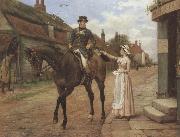 |
George goodwin kilburne -- Click Here
|
|
1839-124
was a London based genre painter specialising in accurately drawn interiors with figures. He favoured the watercolour medium, although he did also work in oils, pencil and in his early career engraving.George was born on the 24th July 1839 in Norfolk. He was apprenticed for five years to the Dalziel brothers in London, studying wood engraving. He married Jenny Dalziel, the daughter of Robert Dalziel - they had three sons and two daughters: George Goodwin Jnr who also became an artist; Charles Robert, William Richard, Florence and Mary Maud. They all lived together at Hawkhurst House, Steeles Road, Hampstead. George abandoned wood engraving for the more versatile and profitable mediums of watercolour and oil painting. His apprenticeship in engraving enhanced the accuracy and detail of his paintings. He quickly became on of the most sought after and well known artists in England. George's wife Janet died in March 1883 and George later married Edith Golightly with who he had two girls, Constance Ivy and Edith May. George's paintings often portrayed the upper classes and ultra-fashionable female beauties in opulent settings. His depiction of this beauty was heightened by his attention to detail with dress, and richly decorated interiors. |
|
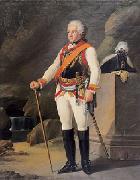 |
Georg Melchior Kraus -- Click Here
|
|
(26 July 1737, Frankfurt am Main - 5 November 1806, Weimar) was a German painter. A student of Johann Heinrich Tischbein, he was also a teacher himself (his pupils included Ferdinand Jagemann), as well as an entrepreneur and friend of Goethe. He was a co-founder of the Ferstliche freie Zeichenschule Weimar with Friedrich Justin Bertuch in 1776.
|
|
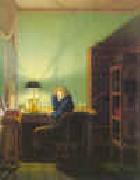 |
Georg Friedrich Kersting -- Click Here
|
|
1785-1847
German
Georg Friedrich Kersting Gallery
Kersting was a friend of Caspar David Friedrich, the leading German Romantic painter; his style was influenced by Friedrich, and he shared that artist's romantic attitude, although in a more subjective manner. The two friends went on a walking tour of the Riesengebirge in 1810. During his many hikes with Friedrich, the two painted numerous sketches and observations from nature. He may have painted the staffage in some of Friedrich's early work??such as Morning in the Riesengebirge (1810?C11), a result of their walking tour.
He was also a friend of the painter Louise Seidler, who described him as "an altogether splendid and comical fellow" and often served as his model. In 1813 Seidler helped Kersting send a number of his works to Johann Wolfgang von Goethe. Goethe was impressed and recommended that the Grand Duke Charles Augustus purchase his work The Embroiderer.
Kersting's most lasting works are his figures in interiors that borrow from seventeenth-century Dutch genre painting. These paintings nevertheless feel contemporary due to the situations depicted and the effect of the artist's personality. The characters are often viewed from the back, as in Friedrich's work, and the scenes provide hints of narrative as the figures engage privately in everyday activities. A number of his works refer to his time in the volunteer corps, the "L??tzow rangers". He drew a full-length self-portrait in 1813, in which he wore the rangers' uniform. The painting On Sentry Duty (1815) depicts three rangers, including the artist Ferdinand Hartmann and the writer Theodor Körner, who fought with Kersting and died in wars against the French. |
|
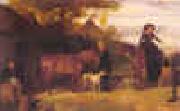 |
Friedrich Wilhelm Keyl -- Click Here
|
|
German (Resident in UK)
1823-1871
|
|
|
|
|
| | |
|
|
|
|